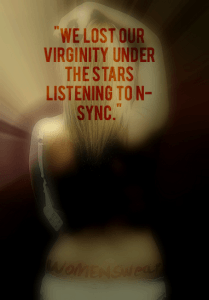Catriona McQuiggan said in an article on arts marketing in the Guardian “As an arts marketer, it’s important to keep experimenting, challenging your assumptions and asking questions.” (The Guardian, 2014). Good arts marketing relies on innovative ideas, and the ability to sense what your audience will connect with – and this was one of my biggest challenges as False Title’s marketing manager.
As we got fully into our process to creating WOMENSwear, asking questions and having conversations amongst each other became an integral part of our rehearsals, prompting interesting and thought provoking answers which could be translated into a script. However, after we had exhausted each other’s histories of womanhood and childhood perceptions, we became hungry for responses from those who had not been in the studio with us, and did not know the play in its entirety. This has become what the majority of our entire online presence is dominated by.
Through talking to the public and engaging with their responses as well as our own, our writer Sam created the “WE…” scenes – short scenes dotted throughout the play, which contain a series of one-liners such as “We wish we could be mermaids” (Thomas, 2015) or “We stayed at home because we didn’t want you to grow up without us” (2015). I saw an opportunity to create a campaign for our online marketing strategy which linked directly to these scenes; editing our flyer image and putting text with these lines on it, to post on social media handles and create interest around the content of WOMENSwear and its core message.
Marketing is essential to a production’s success – not only in getting people to come to the show, but also in engaging people with the themes you’re trying to convey, allowing them to see into your process and each thought pattern behind a scene or a movement. I wanted our presence online to be different and creative, with something for people to look at and think about, instead of passively scrolling through each post on Facebook or Twitter. This is the result:
“I never had a Ken doll; my Barbies were independent, and I liked it that way.” (2015).
“We lost our virginity under the stars listening to N-Sync.” (2015).
When we arrived at the 20 day countdown until the show, I started posting these on Facebook, asking people to send in their own “WE…” sentences, reminding them about dates and times, and where to get tickets. Closer to show day, I also announced a competition which is currently still open, for someone to win two tickets to WOMENSwear by commenting or posting their own “WE…” sentence. This will potentially give us more responses for the script, and will provide more advertisement for the show within our online audience.
For WOMENSwear, my marketing strategy has focused on the script itself and the content in it, as it reflects the connections we have made with audience members, and verbatim writing allows for those connections to be played out on the stage. Rather than post endless rehearsal photos and reminders about the show, I have created marketing material which can be talked about and engaged with by people, that will start conversations, and remind them of their own experiences. This will, in turn, translate onto the stage when we perform WOMENSwear.
Works Cited:
The Guardian (2014) Arts marketing tips from across the cultural sector. [online] London: The Guardian. Available from http://www.theguardian.com/culture-professionals-network/2014/dec/09/arts-marketing-tips-budget-ama [Accessed 8 May 2015].
Thomas, S. (2015) WOMENSwear.

